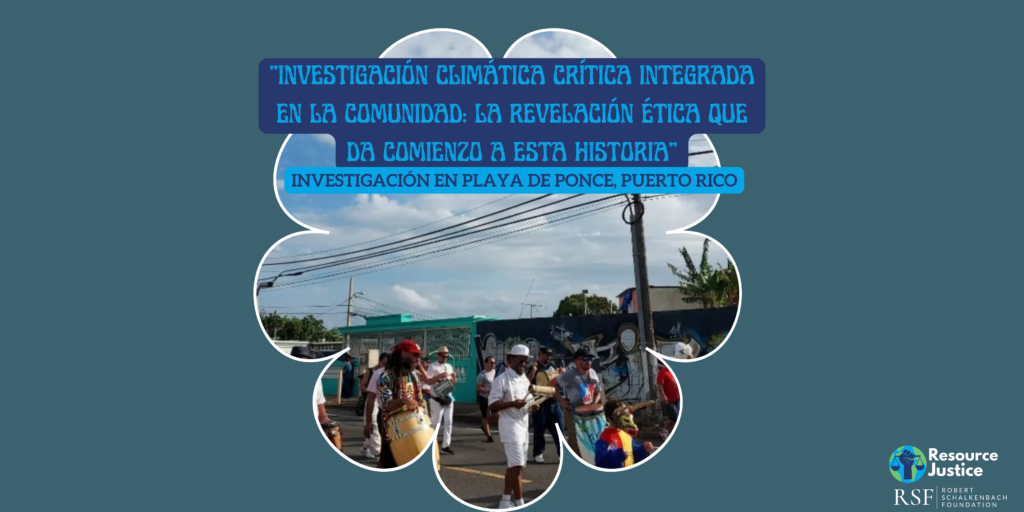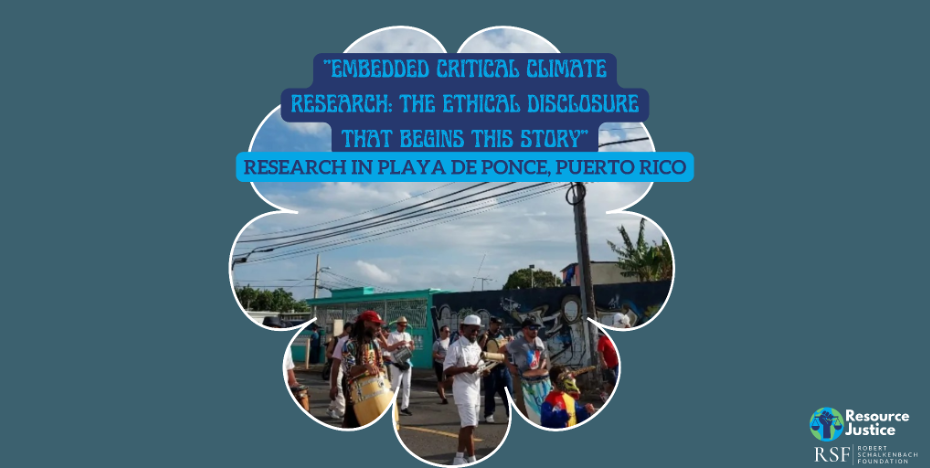(Photo from La Casa de Arte y Cultura de La Playa de Ponce)
By David Southgate
A surge of relief flooded over me as I engaged in candid dialogue with neighborhood leaders about research ethics and my role as a community-embedded critical climate researcher. What had me in knots beforehand wasn’t a struggle for words, nor was it waning confidence about speaking before neighbors and institutional leaders whom I know and respect.
Nor was I uneasy about the possibility that people might perceive that I’d misrepresented myself. Early in all my community relationships, I’d carefully made my threefold identity known. I am a scholar, a neighborhood activist, and a land-use practitioner.
After years of identifying and executing fundable community-led research, I sensed that people were curious––neighborhood leaders in Playa de Ponce, as well as North American frontline leaders and institutions. People had begun to ask me about this strategy of locally rooted climate adaptation. In conversations, on Webinars, people were curious. “Tell us, David. What exactly are you doing in Playa de Ponce, Puerto Rico, and how?”
To answer these questions, and others that will emerge, I have chosen to write about the social dynamics that produce potentially liberating, neighborhood-driven climate adaptation strategies. I have chosen to do so in my community of practice, some 19 neighborhoods in part of south Puerto Rico’s largest coastal Barrio, commonly known as Playa de Ponce, but whose social networks span frontline climate change communities and practitioners across Puerto Rico and the United States. I have chosen to do so with these simple intentions: that my words build on existing community strengths, such as cultural pride, agency, and an inclination towards neighborliness; and that we learn something that contributes to our wellbeing.
To satisfy the broader desire to understand how I work in communities required me to test a new dynamic in my research approach. I am and have openly been a participant in the design of community solutions and research. But I have never deliberately documented the social actions nor discursive themes as a participant-observer. Instead, I made mental notes of what guided my actions.
As a researcher now being tasked with gathering social observations, I am compelled to transparently declare my role and position with community members and institutions that I respect and trust; to negotiate the boundaries on what I will and will not report; and to obtain wherever and whenever possible the consent of those whose identities will remain anonymous.
Clearly, most people don’t have these types of conversations with one another. Being so transparent with my disclosure was new for me. So, dear reader, you might imagine my relief when in four different social settings people generally received the disclosure with a shrug and just a bit of caution about what to record and not record.
The disclosure went something like this: I am compelled to inform you and to seek your feedback, consent, or your refusal to allow me to collect data by observing as a participant how we produce solutions to climate hazards. You know me as a Ph.D. candidate, an activist and researcher interested in land uses, and as a person who helps communities investigate topics that interest them, especially those that inform decisions about how the community would like to adapt to climate change. It is my ethical responsibility to tell you about this, and to share that my intention is to produce reports that promote well-being, not harm. And that I will maintain your anonymity to the best of my ability (National Commission for the Protection of Human Subjects of Biomedical and Behavioral Research, 1979).
These settings and the responses included:
- The community-based organization where I am on the board of directors, Un Nuevo Amanecer, Inc. The board authorized me to use the organization’s name in my writings. But the board also asked me to not discuss sensitive themes about the organization as they are an internal matter.
- A small committee to which I have been nominated, which is leading a quasi-judicial process and whose recommendations have implications for the future of multiple human settlements. Despite no objections from the committee members, an institutional official asked me to take up the theme with the boss.
- An informal gathering of neighbors and federal officials exploring community-desired infrastructure and resilience measures during a field visit to sea-side locations on a warm windy January afternoon. There, the federal contractors declared themselves out of bounds, but others present had no objections.
- An online meeting where a handful of North American community leaders, myself among them, built comradery during existential discussions regarding appropriate climate adaptation strategies, among them community relocations. There, the message “we trust you David” moved me emotionally.
Thus, I begin this journal with the intention to provide readers with a glimpse into a seemingly novel, if not misunderstood or sometimes despised, approach towards critical adaptation planning from a set of neighborhood cases in coastal Puerto Rico, with the hope that my words and observations could benefit others.

(Fotos de La Casa de Arte y Cultura de La Playa de Ponce)
Investigación climática crítica integrada en la comunidad: la revelación ética que da comienzo a esta historia
Por David Southgate
Me invadió un gran alivio cuando entablé un diálogo sincero con los líderes del barrio sobre la ética de la investigación crítica sobre adaptación al cambio climático y mi papel como investigador integrado en la comunidad. Lo que de antemano me hacía un nudo en el estómago no era una lucha por las palabras, ni tampoco una confianza menguante a la hora de hablar ante vecinos y líderes institucionales a quienes conozco y respeto.
Tampoco me inquietaba la posibilidad de que la gente percibiera que me había tergiversado. Al principio de todas mis relaciones comunitarias, había dado a conocer cuidadosamente mi triple identidad: soy un académico, un activista vecinal y una profesional sobre el uso del suelo.
Tras años identificando y ejecutando investigaciones financiables dirigidas por la comunidad, percibí que la gente tenía curiosidad, tanto los líderes vecinales como los líderes comunitarios y los colegas institucionales de Norteamérica. La gente había empezado a preguntarme sobre esta estrategia de adaptación climática arraigada localmente. En conversaciones, en seminarios web, la gente sentía curiosidad. “Cuéntanos, David. ¿Qué estás haciendo exactamente en Playa de Ponce, Puerto Rico, y cómo?”.
Para responder a estas preguntas, y a otras que irán surgiendo, he optado por escribir sobre la dinámica social que produce estrategias de adaptación climática potencialmente liberadoras e impulsadas por los barrios. He elegido hacerlo en mi comunidad de práctica, unos 19 vecindarios que forman parte del Barrio costero más grande del sur de Puerto Rico, conocido comúnmente como Playa de Ponce, pero cuyas redes sociales abarcan comunidades y profesionales de primera línea del cambio climático de todo Puerto Rico y Estados Unidos. Y, he elegido hacerlo con estas sencillas intenciones: Qué mis palabras se basen en las fortalezas existentes en la comunidad, como el orgullo cultural, la agencia y la inclinación hacia la vecindad; y que aprenderemos algo que contribuye a nuestro bienestar.
Satisfacer la sed de comprensión de cómo trabajo en las comunidades me exigió poner a prueba una nueva dinámica en mi enfoque de la investigación. Soy y he sido claramente una participante en el diseño de soluciones comunitarias y en la investigación. Pero nunca he documentado deliberadamente las acciones sociales ni los temas discursivos como participante-observador. En lugar de documentar lo que he observado, tomaba notas mentales que guiaban mis acciones.
Como investigadora a la que ahora se encomienda la tarea de recoger observaciones sociales, me veo obligada a declarar con transparencia mi papel y mi posición ante los miembros de la comunidad y las instituciones que respeto y en las que confío; a negociar los límites sobre lo que informaré y lo que no; y a obtener siempre y cuando sea posible el consentimiento de aquellos cuya identidad permanecerá en el anonimato.
Está claro que la mayoría de la gente no tiene este tipo de conversaciones entre sí. Además, ser tan transparente con mi revelación era algo nuevo para mí. Así que, querido lector, puedes imaginarte mi alivio cuando, en cuatro entornos sociales distintos, la gente recibió la revelación con un encogimiento de hombros y sólo un poco de cautela sobre lo que debía grabar y lo que no.
La revelación era más o menos así: Me veo obligado a informarle y a solicitar su opinión, su consentimiento o su negativa a que me permitan recopilar datos, observando como participante, cómo producimos soluciones a los peligros climáticos. Me conoces como candidata al doctorado, activista e investigador interesado en los usos del suelo, y como persona que ayuda a las comunidades a investigar los temas que les interesan, especialmente los que informan las decisiones sobre cómo la comunidad querría adaptarse al cambio climático. Es mi responsabilidad ética contarlo, y compartir que mi intención es que los informes que elabore hagan el bien y promuevan el bienestar, no que hagan daño. Y que haré todo lo posible por mantener su anonimato en la medida de mis posibilidades (National Commission for the Protection of Human Subjects of Biomedical and Behavioral Research, 1979).
Estos reuniones y las respuestas incluían:
- La organización comunitaria donde soy miembro de la junta directiva, Un Nuevo Amanecer, Inc. La junta me pidió explícitamente que los nombrara, pero que no aireara ningún trapo sucio y me mantuviera alejada de temas con potencial para acarrear consecuencias negativas no deseadas.
- Un pequeño comité para el que he sido nombrada, que dirige un proceso cuasi judicial y cuyas recomendaciones tienen implicaciones para el futuro de múltiples asentamientos humanos. A pesar de que los miembros del comité no se opusieron, un funcionario institucional me pidió que tratara el tema con el jefe.
- Una reunión informal de vecinos y funcionarios federales para explorar las infraestructuras y medidas de resiliencia deseadas por la comunidad durante una visita de campo a lugares junto al mar en una cálida y ventosa tarde de enero. Allí, los contratistas federales se declararon fuera de los límites, pero los demás presentes no pusieron objeciones.
- Una reunión en línea en la que un puñado de líderes comunitarios norteamericanos, entre los que me encontraba, habíamos creado camaradería durante conversaciones existenciales sobre estrategias adecuadas de adaptación al clima, entre ellas la reubicación de comunidades. Allí, el mensaje “confiamos en ti David” me conmovió emocionalmente.
Así pues, comienzo este diario con la intención de proporcionar a los lectores una visión de un enfoque aparentemente novedoso, si no incomprendido o a veces despreciado, hacia la planificación crítica de la adaptación a partir de un conjunto de casos vecinales en la costa de Puerto Rico, con la esperanza de que mis palabras y observaciones puedan beneficiar a otros.

